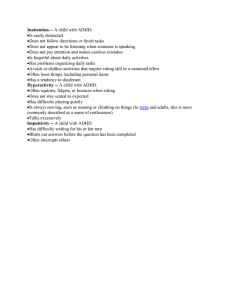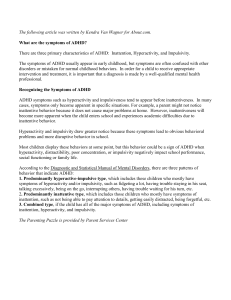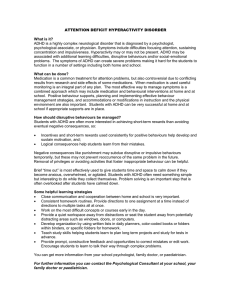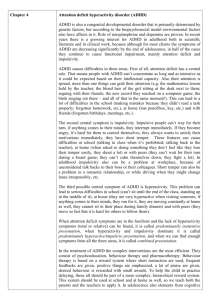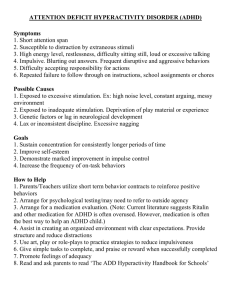DLP SEN - ADHD (Gen Edu Teachers)
advertisement
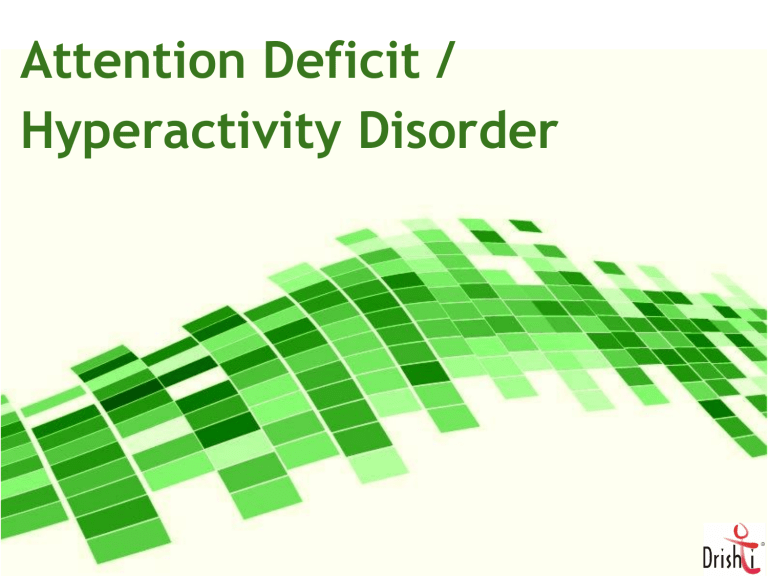
Attention Deficit / Hyperactivity Disorder Case Study MT is a 10 years old male, studying in Grade 4 of an English medium school following the ICSE board curriculum. He lives in an extended family (with grandparents), and has no siblings. The spoken language at home is Gujarati and English. There was no presence of prenatal complications; it was a full term normal delivery (aided by forceps); no post-natal complications reported. He is right handed. He has repeated Sr. Kg as he was younger for his class in school. He has been facing difficulties in coping with academics since grade 2. Currently difficulties are reported with comprehending verbal instructions and speaking in English, Reading comprehension, spellings, written expression, handwriting and Math. Case Study Parent reports of the child’s aversion to any written task. He exhibits very poor attention skills, especially in the classroom. There is considerable hyperactivity in the home environment. Parents report of the presence of considerable aggression and hostility in peer interaction, tantrums at home and lack of self-confidence. Progress report of the current grade indicated below average performance across all subjects, with failure in English language and Math. In grade 3, performance was in the below average range across most subjects. Writing work samples in the classroom indicates incomplete and untidy productions, spelling errors (bizarre spellings) , illegible and immature handwriting, capitalization and punctuation errors. Teachers’ remarks in the notebooks refer to the need to complete written work, participate in class discussions, stop disturbing others, pay attention to verbal instructions. Case Study What is ADHD? ADHD is primarily a condition of brain dysfunction, involving difficulties at multiple sites in the brain, giving rise to educational, behavioral and other difficulties. It especially involves difficulties in concentration, impulse control, hyperactivity, rule governed behavior, motivation and time awareness. Probable Causes Environmental Agents: There is risk for ADHD : ○ In the offspring of the pregnancy where there is a ‘usage of cigarettes and alcohol during pregnancy’ ○ Where there is high level of lead in the bodies of young pre-school children. Brain Injury: ○ A small percentage of children who have suffered accidents leading to brain injury have shown signs of behavior similar to ADHD. Food Activities and Sugar: ○ Symptoms of ADHD are exacerbated by sugar/ food activities. ○ It was also found that diet restrictions helped about 5% of children with ADHD. ○ Biochemical factors Outcome ADHD Inattention Short attention span, disorganized, distractible, forgetful Impulsivity Acts before thinking, difficulty in following rules,blurts out answers, cannot await turn Hyperactivity Restless, overactive, fidgeting, always “on the go” Inattentiveness The child often…. ● fails to give CLOSE attention to details or makes careless mistakes in schoolwork, work or other activities. ● has difficulty sustaining attention in tasks or play activities. ● does not seem to listen when spoken to directly. ● does not follow through on instructions and fails to finish schoolwork, chores or work duties. ● has difficulty organizing tasks or activities. ● avoids, dislikes, or is reluctant to engage in tasks that require sustained mental effort. ● loses things necessary for tasks or activities. ● easily distracted by extraneous stimuli. ● is forgetful in daily activities. Hyperactivity The child often…. ● fidgets ● is often Out of seat in class Often runs about or climbs excessively in situations in which it is appropriate. ● has difficulty playing or engaging in leisure activities quietly. ● is often ‘on the go’ or often acts as if ‘ driven by a motor’. ● often talks excessively. Impulsivity The child often…. ● blurts out answers before questions have been completed. ● has difficulty awaiting turn. ● interrupts or intrudes on others. ● exhibits physical impulsiveness ● exhibits verbal impulsiveness ● exhibits emotional impulsiveness Presentations in Adolescence & Adulthood ● Sense of inner restlessness rather than hyperactivity ● Poor organizational skills; difficulty working independently ● Engaging in excessive risk taking, e.g., speeding while driving ● Difficulty with authority figures ● Poor self esteem ● Poor peer relations ● Emotional labile (unpredictable outbursts) ● Underachievement in school and workplace Procedure for Help Intervention Primary Intervention Bi-modal: Pharmacology (medication) & Behaviour therapy Supportive Intervention Remedial education therapy, parent counselling, teacher awareness Benefits of Medication ● 75% have real overall improvement in behavior ● Increase attention span, decrease hyperactivity and decrease impulsiveness ● Able to remain on boring, repetitive activities ● Grades in school improve ● Better social relationships Behavior Modification 4 Steps To Success Behavior Modification ● Providing more frequent and immediate feedback (including rewards and punishment) ● Setting up more structure in advance of potential problem situations ● Providing greater supervision and encouragement to children with ADHD in relatively unrewarding or tedious situations. ● Modeling behaviour by encouraging good behaviour with healthy praise or rewards. This works best if the reward or praise immediately follows the positive behaviour. ● Negatively reinforcing behaviour by allowing appropriate consequences to occur naturally. What Counselors can do... ● Individual therapy using cognitive-behavioral approaches can be very helpful in the treatment of Attention Deficit Disorder ADHD. ● Stop and Think Therapy, teaching the ADHD child how to solve problems, and teaching him how to decrease his impulsivity is great. ● Teaching the child how to monitor his own behaviors is important as well. ● Academic related concerns ○ time management, planning, and organizational tasks. A counselor helps persons with ADHD develop strategies for managing their academic responsibilities and monitors progress towards these goals. ● A counselor can be helpful in treating some of the issues frequently associated with ADHD, including low self-confidence, anxiety, and depression. ● The counselor can also help to identify and build on strengths, cope with daily problems, and control attention and aggression. What Parents can do... ● Explanations should be given to the child, but these must be tailored to take account of individual capacities. ● Regular liaison with all professionals involved is essential. ● Behaviour modification approach known to be most effective. ● Dietary manipulation and other alternative therapies is as yet unproven. Management of ADHD in the classroom 3 elements of change: You can BET on it!! ❖ Modification of Behaviour ❖ Modification of Environment ❖ Modification of Task Modify Behaviour • Improve attention to directions • Use systematic praise and ignoring • Call time-out for disruptive behaviours. Use desirable activity periods for time-out • Immediately draw attention for off-task behaviour • Token reinforcement (stars, coins, smileys) • Positive /corrective feedback should immediately follow the behaviour Modify Environment • • • • • • • Position of child/place in classroom Least distracting position Vary class schedule Identify a ‘study buddy’ Teacher-student relationship Teacher expectations Instructional methodology Modify Task • • • • • One assignment at a time Vary tasks (keep it interesting, challenging, yet achievable) Use ‘active’ tasks Break assignment into smaller parts Alter or decrease written workload General Strategies ● Schedule a consistent routine. Have the same routine every day, from wake-up time until bedtime. The schedule should include time for homework and time for play (including outdoor recreation and indoor activities such as computer games). Have the schedule on the refrigerator or a bulletin board in the kitchen. If a schedule change must be made, make it as far in advance as possible. ● Organize items that are needed every day. Have a place for everything and keep everything in its place. This includes clothing, backpacks, and school supplies. ● Use homework and notebook organizers. Stress the importance of writing down assignments and bringing home needed books. ● Create and enforce rules. Children with ADHD need consistent rules that they can understand and follow. If rules are followed, give small rewards. Children with ADHD often receive and expect criticism. Look for good behavior and praise it. Strategies : Specific Behaviours 'Slowing the Motor' Helping the Hyperactive/Impulsive Student to Manage Problem Motor or Verbal Behaviors Activity : Give the student a soft 'stress ball' and encourage the student to squeeze it whenever he or she feels the need for motor movement. Or if the setting is appropriate, allow the student to chew gum as a replacement motor behavior. 'Slowing the Motor' Activity : Selective ignoring can be an effective teacher response to minor fidgeting or other motor behaviors. 'Slowing the Motor' Activity :Take away (or direct the student to put away) any items that the student does not need for the work assignment but might be tempted to play with (e.g., extra pens, paper clips). Bringing into Focus: Helping Students to Attend to Instruction Activity : Allow them brief 'attention breaks'. Contract with students to give them short breaks to engage in a preferred activity each time that they have finished a certain amount of work. For example, a student may be allowed to look at a favorite comic book for 2 minutes each time that he has completed five problems on a math worksheet and checked his answers. Attention breaks can refresh the student –and also make the learning task more reinforcing. Bringing into Focus: Helping Students to Attend to Instruction Activity :This 'advance organizer' provides students with a mental schedule of the learning activities, how those activities interrelate, important materials needed for specific activities, and the amount of time set aside for each activity. ‘Extinguishing the Blaze’: & Helping Students to Keep Their Cool Activity: Select a corner of the room (or area outside the classroom with adult supervision) where the target student can take a brief 'respite break' whenever he or she feels angry or upset. Be sure to make cool-down breaks available to all students in the classroom, to avoid singling out only those children with anger-control issues. ‘Extinguishing the Blaze’: & Helping Students to Keep Their Cool Activity: You can pose ‘who’, ‘what’, ‘where’, ‘when’, and ‘how’ questions to more fully understand the problem situation and identify possible solutions. Some sample questions are "What do you think made you angry when you were talking with Billy?" and "Where were you when you realized that you had misplaced your science book?" One caution: Avoid asking ‘why"’questions because they can imply that you are blaming the student. Myths ● All children with "ADHD" outgrow it ● ADHD is not a physiological condition ● Bad parenting and indiscipline is responsible for the condition ● Affects males much more than females ● Can only be treated with medication ● Medication is not helpful in adolescence/adults FACTS ● ADHD is a lifelong condition; it is not curable; it is manageable ● ADHD is a neurological condition ● Poor parenting and discipline can only worsen the situation, not cause it ● Males are identified more than females ● Multi-modal therapy, i.e. Medication and behavioural therapy is the best treatment option for ADHD. Conclusions ● Characterized by Inattention, Hyperactivity, and Impulsivity ● The worldwide prevalence is estimated to be 3% to 7% ● Impairments often occur in home, school, and job settings and persist from childhood through adulthood ● Genetic factors often contribute to the etiology ● Dyslexia is life-long ● In ADHD, hyperactivity diminishes but inattention remains Case Study MT is a 10 years old male, studying in grade 4 of an English medium school following the ICSE board curriculum. He lives in an extended family (with grandparents), and has no siblings. The spoken language at home is Gujarati and English. There was no presence of prenatal complications; it was a full term normal delivery (aided by forceps); no post-natal complications reported. He is right handed. He has repeated Sr. Kg as he was younger for his class in school. He has been facing difficulties in coping with academics since the primary school grades. Currently difficulties are reported with comprehending verbal instructions and speaking in English, Reading comprehension, spellings, written expression, handwriting and Math. Case Study Parent reports of the child’s aversion to any written task. He exhibits very poor attention skills, especially in the classroom. There is considerable hyperactivity in the home environment. Parents report of the presence of considerable aggression and hostility in peer interaction, tantrums at home and lack of self-confidence. Progress report of the current grade indicated below average performance across all subjects, with failure in English language and Math. In grade 3, performance was in the below average range across most subjects. Writing work samples in the classroom indicates incomplete and untidy productions, spelling errors (bizarre spellings) , illegible and immature handwriting, capitalization and punctuation errors. Teachers’ remarks in the notebooks refer to the need to complete written work, participate in class discussions, stop disturbing others, pay attention to verbal instructions. Case Study A psycho-educational assessment indicates VIQ as being in the above average range and PIQ & FSIQ to be in the average range. Scores on a standardized achievement test shows MT to be functioning 1.6-2 years below his grade level in the areas of reading comprehension, written expression & Math. Curriculum based assessment indicated oral reading, reading comprehension and written expression functioning at beginning of grade level 3. Reading errors made were largely mispronunciations; reading comprehension and written expression tasks reflected poor vocabulary skills, syntax & spelling errors. Mild-moderate deficits were present in the areas of auditory processing, visual-motor integration, and memory skills. Case Study Information from parents and school indicated great concerns in the areas of inattention, hyperactivity/impulsivity. Significant concerns were expressed in the area of executive functioning and peer relations. Results on emotional and behavioral evaluations indicated significant emotional conflict and behavioral difficulties. Presence of ADHD was diagnosed. This is accompanied by emotional difficulties, deficits in spoken English language, and severe learning difficulties, The student was recommended to consult a pediatric neurologist for the problem of ADHD, begin with behavioral therapy, occupational therapy and Remedial Education therapy. Case Study Behavioural therapy was recommended for a duration of six months. The goals to be attended to as stated in his counselling plan were management of inattention and hyperactivity, building up self-esteem, increasing motivation for academic tasks. Parent involvement was focal to the plan. Outcome of therapy indicated improved attention span during remedial therapy sessions; but classroom disturbances continued. Medication was administered by the Neurologist. This is reviewed after a period of 3 months. Occupational therapy has helped with attention skills and handwriting skills. Case Study Remedial therapy was recommended for duration of a year, at a frequency of 2 hours a week. Goals in the areas of behaviour modification, social skills, perception-auditory & visual, spoken language, word reading, reading comprehension, spellings, grammar, written language were included in the IEP. Remedial methods involved use of phonetics and sight word reading methods, word lists for word reading; vocabulary development and story telling for reading comprehension; various word lists, phonetics and sight word methods for spellings; visual stimulation, story starters, role-play, etc for written expression. Goal evaluation for progress reporting indicated that MT is now functioning at middle or end of grade level 4 across the different areas; he shows a progress of approximately 6 months-1 year through application of multi-modal therapy. Reference Links http://www.nimh.nih.gov/health/publications/attention-deficit-hyperacti vity-disorder/complete-index.shtml http://kidshealth.org/parent/medical/learning/adhd.html http://www.adhdnews.com/adhd-information.htm
